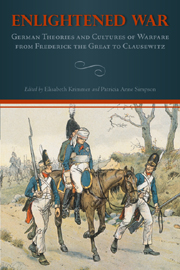Book contents
- Frontmatter
- Contents
- List of Illustrations
- Acknowledgments
- Introduction: Enlightened Warfare in Eighteenth-Century Germany
- Part I War and Enlightenment
- Part II Cultures of War in Classicism and Romanticism
- 3 Agamemnon on the Battlefield of Leipzig: Wilhelm von Humboldt on Ancient Warriors, Modern Heroes, and Bildung through War
- 4 War, Anecdotes, and the Backsides of Reason: Kleist with Kant
- 5 “Schon wieder Krieg! Der Kluge hörts nicht gern”: Goethe, Warfare, and Faust II
- 6 Recoding the Ethics of War in Grimms' Fairy Tales
- Part III War and Gender
- Part IV War and Theory
- Bibliography
- Notes on the Contributors
- Index
6 - Recoding the Ethics of War in Grimms' Fairy Tales
from Part II - Cultures of War in Classicism and Romanticism
Published online by Cambridge University Press: 05 February 2013
- Frontmatter
- Contents
- List of Illustrations
- Acknowledgments
- Introduction: Enlightened Warfare in Eighteenth-Century Germany
- Part I War and Enlightenment
- Part II Cultures of War in Classicism and Romanticism
- 3 Agamemnon on the Battlefield of Leipzig: Wilhelm von Humboldt on Ancient Warriors, Modern Heroes, and Bildung through War
- 4 War, Anecdotes, and the Backsides of Reason: Kleist with Kant
- 5 “Schon wieder Krieg! Der Kluge hörts nicht gern”: Goethe, Warfare, and Faust II
- 6 Recoding the Ethics of War in Grimms' Fairy Tales
- Part III War and Gender
- Part IV War and Theory
- Bibliography
- Notes on the Contributors
- Index
Summary
The state of peace among men living in close proximity is not the natural state (status naturalis); instead, the natural state is one of war, which does not just consist in open hostilities, but also in the constant and enduring threat of them.
— Immanuel Kant, To Perpetual Peace: A Philosophical Sketch (1795)IT SEEMS UNLIKELY TO FIND WAR, its consequences and ethos, at home in the Grimms' fairy tales. In this chapter I contend that the ethical framework of three of the Grimms' tales with soldiers as protagonists reflects a contemporary culture of war. This reading of war stories inscribed within the larger discourse of populist fairy tales and military theory argues that a close connection exists between the soldier tales and the historical context, particularly with regard to gendered bourgeois identity. The daunting success of the post-revolutionary French army until the Russian campaign, the Wars of Liberation, and, finally, Waterloo prompted a sustained interrogation of military masculinity and the identity of the citizen-soldier in German-speaking Europe. In 1815, the publication year of the Grimms' “children's and household” tales, the issue of reintegrating discharged soldiers into civil society and the domestic sphere became urgent. In the immediate postwar context, the transition from a culture of war to a context of family and commerce was effected through reconfiguring military masculinity to incorporate alternative models of male identity.
- Type
- Chapter
- Information
- Enlightened WarGerman Theories and Cultures of Warfare from Frederick the Great to Clausewitz, pp. 151 - 172Publisher: Boydell & BrewerPrint publication year: 2011

